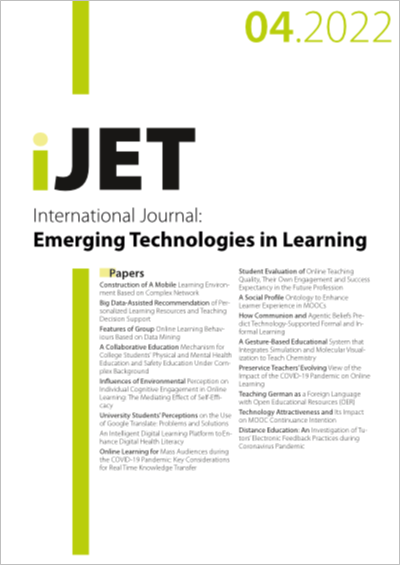A Gesture-Based Educational System that Integrates Simulation and Molecular Visualization to Teach Chemistry
DOI:
https://doi.org/10.3991/ijet.v17i04.26503Keywords:
chemistry, simulation, e-learning, gesture-based technology, virtual labs, 3D visualizationAbstract
Technology has proven effective in enhancing teaching methods. Gesture-based applications have a high potential for use in the development of teaching methods in schools. Simulation and 3D visualization, in particular, are some of the most important technologies that positively affected education. The implementation of these technologies in the education sector can determine students’ potential and enhance their interest in learning in scientific fields. This study explored the use of a chemistry education system that integrates virtual simulation and molecular visualization and uses a Leap Motion controller to teach chemistry in secondary schools. The sample comprised 113 students enrolled in four different classes in a public secondary school in Saudi Arabia. The data were analyzed using an ANOVA test to compare the results. The results indicate that the students who used the proposed educational system achieved better learning results than the students who participated in theoretical classroom learning only. Moreover, students who used the proposed educational system learned microscopic-level concepts better than those who used a real chemistry laboratory. Finally, combining simulation and molecular visualization and using gesture-based technology has a significant and positive effect on the students’ learning experience, as demonstrated by the results of this study which contributes to the development of education through the utilization of modern technology.
Downloads
Published
2022-02-28
How to Cite
Aldosari, S. S., Ghita, B., & Marocco, D. (2022). A Gesture-Based Educational System that Integrates Simulation and Molecular Visualization to Teach Chemistry. International Journal of Emerging Technologies in Learning (iJET), 17(04), pp. 194–211. https://doi.org/10.3991/ijet.v17i04.26503
Issue
Section
Papers
License
Copyright (c) 2022 Shaykhah S. Aldosari, Bogdan Ghita, Davide Marocco

This work is licensed under a Creative Commons Attribution 4.0 International License.


